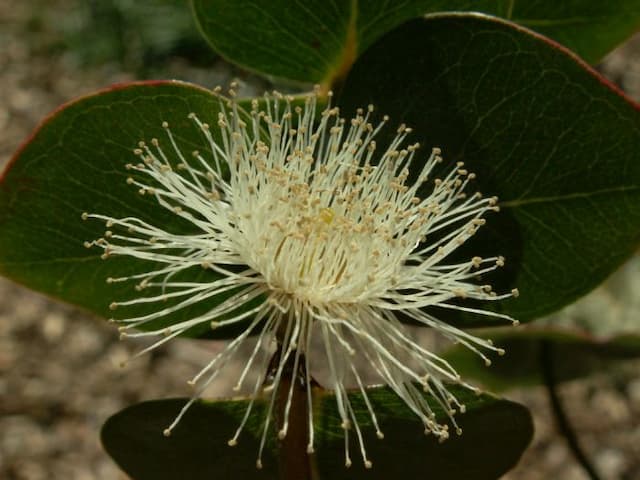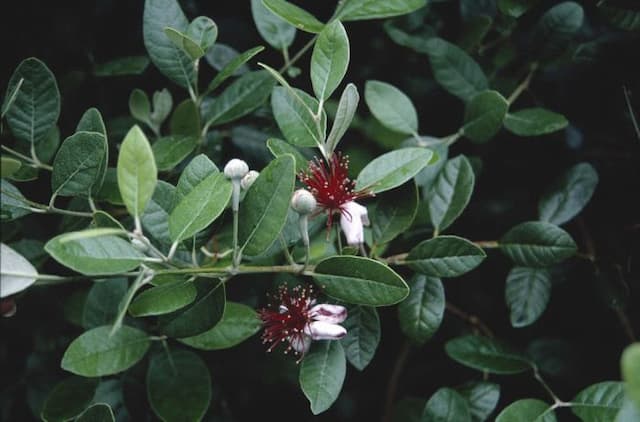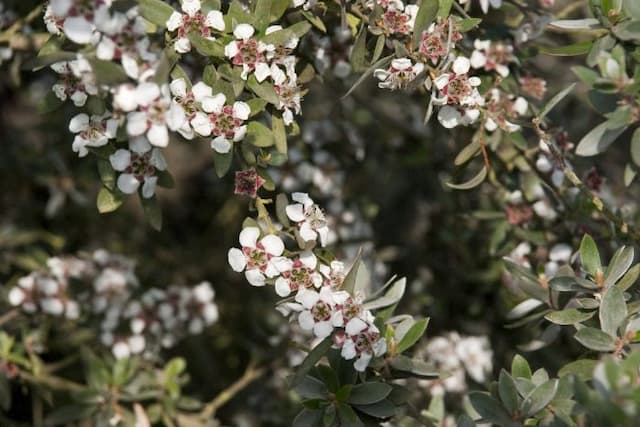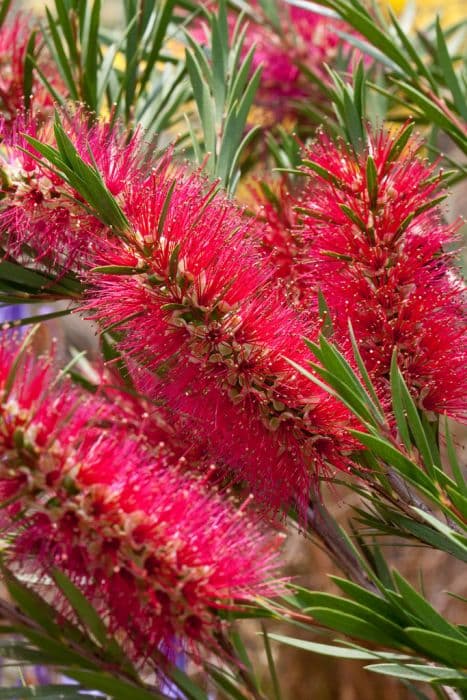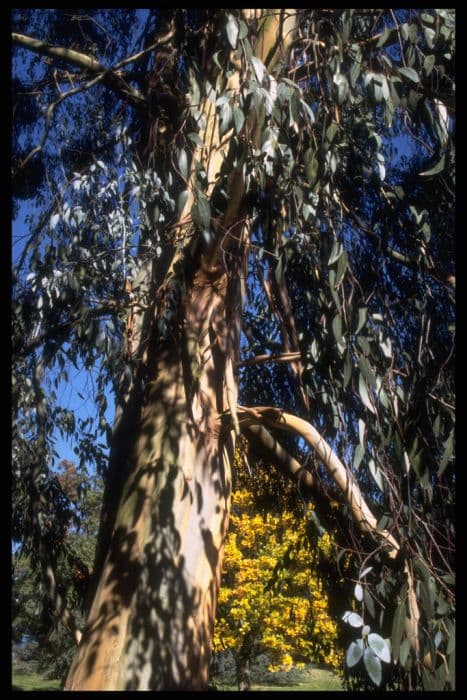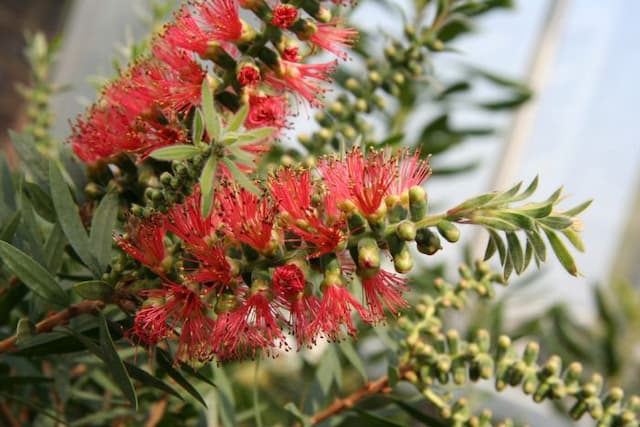Yellow strawberry guava Psidium littorale var. longipes (F)

ABOUT
Psidium littorale var. longipes, commonly known as the yellow strawberry guava, is a visually striking plant that displays lovely features throughout its form. The plant bears smooth, glossy green leaves that have a slightly oval shape with pointed tips. The leaves arrange themselves oppositely along the slender branches, creating a dense canopy of foliage that can offer a lush appearance. The yellow strawberry guava is adorned with attractive white flowers that usually have numerous stamens at the center, giving them a delicate, brush-like appearance. These flowers stand out against the deep green of the leaves, drawing attention with their simple yet elegant beauty. After the flowering stage, the plant produces small, edible fruits that boast a cheerful yellow hue. The fruits are roughly the size of a cherry and have a somewhat rounded shape with a slight dimple at the end opposite the stem. They are known for their sweet and tangy flavor, which is reminiscent of both strawberries and guavas, hence the name. The bark of the yellow strawberry guava is smooth with a mottled appearance, featuring shades of brown and gray. As it ages, the bark may become slightly more textured, adding to the overall aesthetic appeal of the plant. The visual characteristics of the yellow strawberry guava contribute to its popularity as both an ornamental plant and a fruit-bearing tree for gardens and landscapes. Its combination of lush foliage, charming flowers, and colorful fruits make it a delightful addition wherever it can be appropriately cultivated, offering both beauty and practical benefits.
About this plant
 Names
NamesFamily
Myrtaceae
Synonyms
Yellow Strawberry Guava, Lemon Guava, Waiawi
Common names
Psidium cattleianum var. lucidum, Psidium littorale var. cattleianum.
 Toxicity
ToxicityTo humans
The plant Psidium littorale var. longipes, commonly known as cattley guava or strawberry guava, is not known to be toxic to humans. In fact, the fruit of the cattley guava is edible and often eaten fresh or used in jams and jellies. There is no well-documented evidence that suggests this plant has any toxic effects when ingested by humans. However, as with the consumption of any plant material, individual allergies or sensitivities may occur, so it is always advisable to consume in moderation especially if you have never eaten it before.
To pets
Cattley guava is not known to be toxic to pets either. The fruit of the cattley guava is edible and is not associated with poisoning in pets. However, as with all non-traditional pet foods, individual animals might have sensitivities or allergic reactions to this fruit. It is always best to introduce any new food into your pet's diet gradually and to consult with a veterinarian if you have any concerns about the safety of feeding this fruit to your pet.
 Characteristics
CharacteristicsLife cycle
Perennials
Foliage type
Evergreen
Color of leaves
Green
Flower color
White
Height
10 7 (3.23)
Spread
10 7 (3.23)
Plant type
Shrub
Hardiness zones
9
Native area
Brazil
Benefits
 General Benefits
General Benefits- Nutritional Value: Psidium littorale var. longipes, commonly known as yellow strawberry guava, provides essential nutrients such as vitamins and minerals to the diet.
- Edible Fruit: The plant produces edible fruits that can be eaten fresh, used in jams, jellies, or as flavoring in various dishes.
- Ornamental Use: With its attractive foliage and fruits, yellow strawberry guava is often grown for ornamental purposes in gardens and landscapes.
- Habitat Support: The plant can provide habitat and food for a variety of wildlife, including birds and insects.
- Shade and Shelter: As a tree or large shrub, it offers shade and shelter in garden settings and can contribute to a pleasant microclimate.
- Cultural Significance: In certain cultures, yellow strawberry guava is an integral part of traditional gardening practices and cuisine.
- Erosion Control: As a perennial with a strong root system, it can help prevent soil erosion in certain environments.
- Pollinator Attraction: The flowers of the yellow strawberry guava can attract pollinators like bees, which are essential for the pollination of many plants.
 Medical Properties
Medical Properties- Antioxidant activity: Contains compounds that may help protect cells from damage by free radicals.
- Antimicrobial effects: Has potential to inhibit growth of certain bacteria and fungi.
- Anti-inflammatory properties: Might be used to reduce inflammation in the body.
- Gastroprotective effects: Could help in protecting the stomach lining and might be beneficial for gastric ailments.
- Antidiabetic potential: May have compounds that could help in managing blood sugar levels.
- Analgesic properties: May possess pain-relieving qualities.
- Anticancer potential: Contains constituents that may exhibit anticancer activity in vitro.
 Air-purifying Qualities
Air-purifying QualitiesThis plant is not specifically known for air purifying qualities.
 Other Uses
Other Uses- The leaves of the Yellow Strawberry Guava can be used to create a natural dye for fabric, imparting a yellowish hue.
- Wood from the Yellow Strawberry Guava tree is suitable for crafting small wooden tools or utensils due to its hard and durable nature.
- Yellow Strawberry Guava fruit pulp can be used as a natural sweetener in various recipes as a substitute for sugar.
- The bark of the Yellow Strawberry Guava tree, rich in tannins, can serve in the tanning industry for processing leather.
- Crushed leaves and fruit can be spread in garden areas as an organic insect repellent, thanks to their aromatic properties.
- Yellow Strawberry Guava seeds can be roasted and used as a coffee substitute or additive for their flavor.
- Due to its dense foliage, the plant can be used as a privacy hedge or living fence in tropical and subtropical gardens.
- The flowers of the Yellow Strawberry Guava can be used for ornamental purposes in floral arrangements.
- The fruit's low pH and natural pectin make it a good candidate for homemade jelling agents or fruit preserves.
- Fallen Yellow Strawberry Guava leaves can be collected and used as mulch, providing nutrients as they decompose and improving soil quality.
Interesting Facts
 Feng Shui
Feng ShuiThe Yellow Strawberry Guava is not used in Feng Shui practice.
 Zodiac Sign Compitability
Zodiac Sign CompitabilityThe Yellow Strawberry Guava is not used in astrology practice.
 Plant Symbolism
Plant Symbolism- Resilience: Given this plant's ability to thrive in various conditions, it commonly symbolizes resilience and adaptability.
- Protection: As a species in the myrtle family, it is often associated with protection due to the hard, protective nature of its wood and evergreen leaves.
- Renewal: The plant's persistent fruiting cycle represents renewal and the continuous circle of life.
 Water
WaterThe Strawberry Guava should be watered thoroughly, ensuring that the water penetrates deep into the soil to encourage healthy root growth. It’s ideal to water the plant once a week with approximately 1 to 1.5 gallons of water, but this can vary depending on climate and soil conditions. During hotter periods, the plant may need additional water. It's important to check the top inch of the soil; if it feels dry to the touch, it’s time to water the plant again. Avoid over-watering as standing water or overly wet soil can lead to root rot.
 Light
LightStrawberry Guava thrives in full sun to partial shade conditions. It should be planted in a location where it can receive at least 6 hours of direct sunlight daily. However, if you are in a region with excessively hot summers, providing some afternoon shade will help prevent the leaves from getting sunburned.
 Temperature
TemperatureStrawberry Guava performs best in a temperature range between 60°F and 85°F. It can tolerate a minimum temperature of about 20°F, but temperatures below freezing can be detrimental to the plant. The ideal conditions for the Strawberry Guava would include warm days and cooler nights within the specified temperature range.
 Pruning
PruningPruning the Strawberry Guava is important for maintaining its shape, encouraging fruit production, and removing any dead or diseased branches. Prune the plant lightly during the late winter or early spring before new growth begins. Pruning can be done annually, focusing on shaping the tree and thinning out any crowded branches to allow light and air to penetrate the canopy.
 Cleaning
CleaningAs needed
 Soil
SoilThe Yellow Strawberry Guava requires well-draining soil with a pH of 5.0 to 7.0. A mix of peat, perlite, and compost is ideal to ensure proper drainage and fertility. Ensure regular fertilization during the growing season.
 Repotting
RepottingYellow Strawberry Guava should be repotted every 2 to 3 years. The best time to repot is in early spring before the growing season, allowing the roots to establish in the new pot.
 Humidity & Misting
Humidity & MistingThe Yellow Strawberry Guava thrives at a humidity level of 50-60%. It is tolerant of both humid and somewhat drier conditions, but consistent humidity is beneficial for optimal growth.
 Suitable locations
Suitable locationsIndoor
Place in bright, indirect light and ensure good air circulation.
Outdoor
Plant in well-draining soil, full sun to partial shade.
Hardiness zone
9-11 USDA
 Life cycle
Life cyclePsidium littorale var. longipes, commonly known as Yellow Strawberry Guava, begins its life cycle with seed germination, which occurs in warm, moist soil and can take several weeks to months. Following germination, the seedling emerges and develops into a juvenile plant with a growing stem and foliage. As the plant matures, it enters the vegetative stage, characterized by the development of branches and leaves, allowing for photosynthesis and further growth. The next stage is the flowering phase, during which the plant produces white, aromatic flowers that attract pollinators. After successful pollination, the flowers develop into the yellow fruit, which is the guava that contains seeds for the next generation. Finally, as a perennial plant, the Yellow Strawberry Guava can produce fruit over many years while continuing vegetative growth.
 Propogation
PropogationPropogation time
Spring-Early Summer
The most popular method of propagation for Psidium littorale var. longipes, commonly known as Yellow Strawberry Guava, is through seeds. The best time to sow seeds is during spring or early summer, when temperatures are warm enough to encourage germination. Seeds should be extracted from fully ripe fruits and cleaned from the fruit pulp. After cleaning, they are sown in a well-draining germination mix and lightly covered with soil. The seeds generally germinate in 2-4 weeks. It is important to keep the soil consistently moist but not waterlogged and to provide the seedlings with bright, indirect light as they grow. Once the seedlings have developed several true leaves, they can be transplanted into individual pots.
